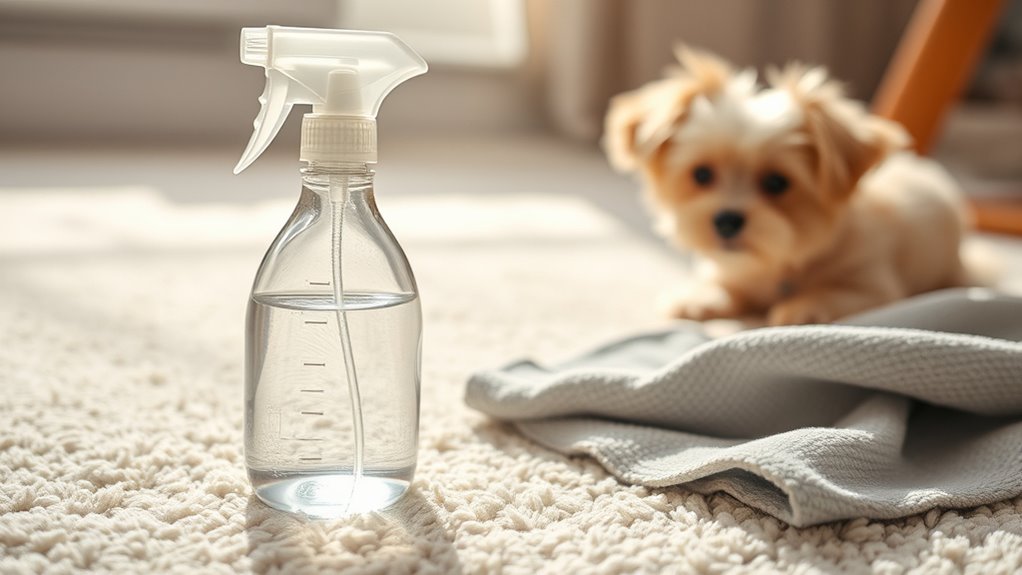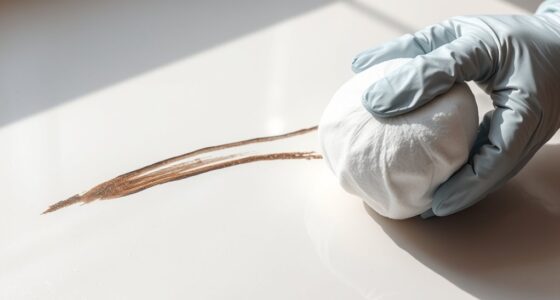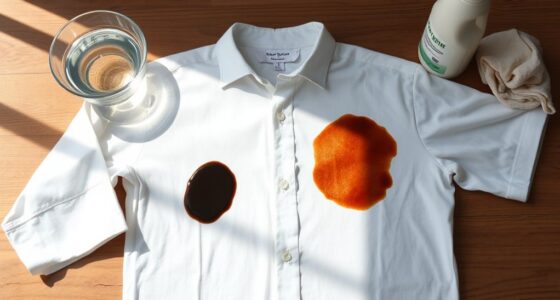To effectively remove pet urine from carpets, start by blotting fresh stains with a clean cloth. Use enzyme cleaners to break down the urine’s components and a wet/dry vacuum to extract moisture. For set-in stains, try baking soda and vinegar or hydrogen peroxide carefully. Always follow up with a rinse and consider professional cleaning for stubborn odors. Want to discover additional tips and tricks for maintaining a clean carpet? Keep exploring this ultimate guide!
Key Takeaways
- Blot fresh stains immediately with a clean cloth to absorb as much liquid as possible before applying any cleaning solution.
- Use enzyme cleaners specifically designed to break down urine proteins and eliminate odors effectively.
- For set-in stains, apply a baking soda and vinegar mixture or hydrogen peroxide to help lift discoloration and neutralize smells.
- Utilize a wet/dry vacuum to extract cleaning solutions and remaining urine for thorough removal and drying of the affected area.
- Consider professional cleaning services for advanced techniques and equipment to restore carpets and eliminate persistent odors.
Understanding Pet Urine Stains
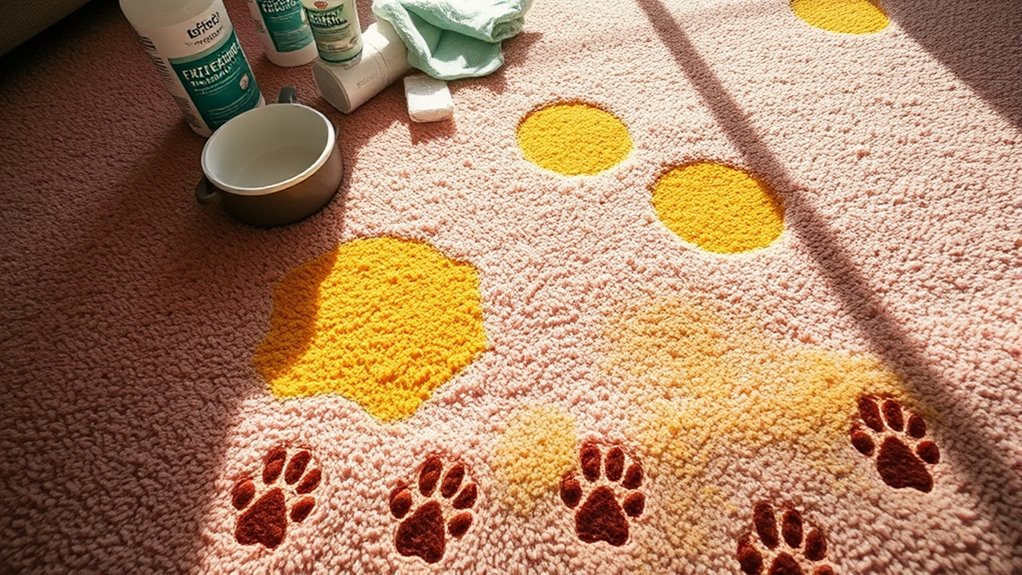
When it comes to understanding pet urine stains, it’s essential to recognize their complex chemical makeup. Urine contains urea, creatinine, and uric acid, which can bind to your carpet fibers. When the urine dries, it forms crystals that make removal tough, even with basic cleaning methods. You might notice that urine can also affect the carpet’s dye, leading to color changes or permanent stains, depending on its content and your carpet type. Additionally, odors can linger due to bacteria and compounds that standard cleaning might miss. The urine’s variation—based on diet, health, or age—also influences how easily you can remove the stain. Recognizing these factors helps you tackle the issue more effectively. Understanding these factors can aid in better cleaning outcomes helps ensure that you are prepared for any challenges that arise during the cleaning process.
Essential Tools and Materials for Stain Removal
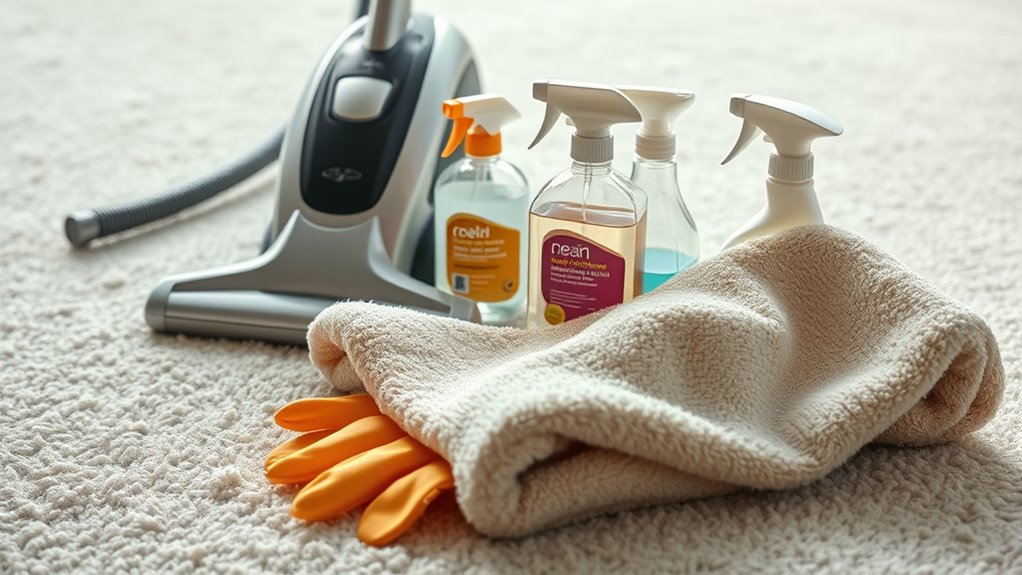
To effectively tackle pet urine stains, having the right tools and materials at your disposal makes all the difference.
Start with enzyme cleaners, which break down the proteins in urine, and a vinegar and water mix for fresh stains. You’ll also want a wet/dry vacuum to extract cleaning solutions efficiently. Enzymes take time to work to ensure maximum effectiveness, so reapplication may be necessary.
Begin with enzyme cleaners to tackle urine stains, and use a vinegar-water mix for fresh spots. A wet/dry vacuum aids in effective extraction.
A UV light helps spot hidden stains, while microfiber cloths are perfect for blotting. For tough stains, consider using a drill brush or old toothbrush to agitate the area gently.
Don’t forget gloves for protection and guarantee good ventilation during cleaning.
Finally, a carpet cleaning machine can be invaluable for large or heavily stained areas, making your task easier and more effective.
Steps for Removing Fresh Pet Urine Stains

Act quickly to remove fresh pet urine stains, as immediate action can prevent permanent damage to your carpet.
Start by blotting the area with a clean cloth or paper towel, soaking up as much urine as you can without rubbing.
Next, apply an enzyme cleaner to break down the proteins and neutralize odors; let it sit for about five minutes. Enzyme-based cleaners are particularly effective for this purpose.
Use a wet-dry vacuum to extract the cleaner and remaining urine thoroughly. If needed, rinse with cool water and blot dry.
To manage odors, sprinkle baking soda over the area and let it sit overnight before vacuuming.
Avoid harsh chemicals, and always test any cleaning product on a hidden carpet area first.
Techniques for Treating Set-in Urine Stains
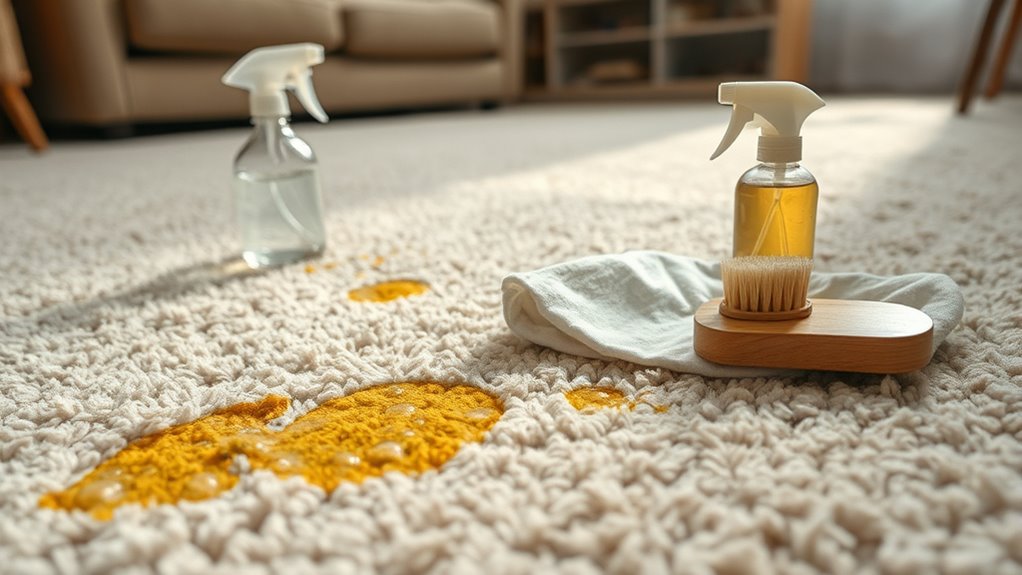
Because set-in urine stains can be stubborn, using the right techniques is essential for effective removal.
Start by applying enzyme cleaners, which break down the uric acid crystals and other compounds in pet urine. If the stain has yellowed, hydrogen peroxide can help lighten it, but be cautious on dark carpets as it may bleach the fibers. Enzyme cleaners effectively break down organic matter like urea and odor-causing molecules.
You can also try a baking soda and vinegar mix, which works well for many stains. For an alternative, vodka-based solutions can neutralize odors and loosen set-in stains.
Don’t forget to use agitation tools like drill brushes to help lift the stains from the carpet fibers. Always test any solution on a small area first to avoid damage.
Advanced Cleaning Methods and Professional Assistance
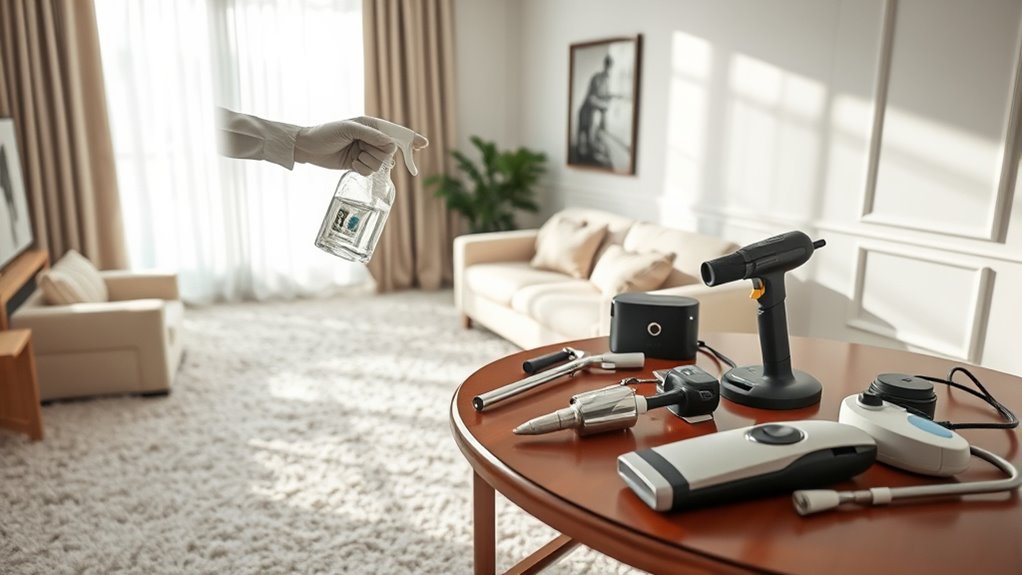
For persistent pet urine stains that resist DIY methods, advanced cleaning techniques and professional assistance can make a significant difference.
Start by blotting the stain immediately and rinsing the area with plain water to prevent deeper penetration. Utilize enzyme-based treatments to break down odors or apply a vinegar solution to neutralize urine alkalinity. A wet/dry vacuum can help extract excess liquid effectively. Moisture from urine can weaken carpet layers, making it crucial to address any accidents promptly.
Blot the stain promptly, rinse with water, and use enzyme treatments or vinegar solutions for effective odor neutralization.
If challenges persist, consider hiring professional cleaners who use specialized equipment and expert techniques tailored to your carpet type. They can deep clean and neutralize odors while applying protective measures for future accidents.
With their help, you can restore your carpet and maintain a fresh environment for both you and your pet.
Frequently Asked Questions
Can Pet Urine Stains Damage My Carpet Permanently?
Yes, pet urine stains can permanently damage your carpet if not addressed quickly.
The urine’s pH changes over time, promoting bacterial growth that causes odors and weakens fibers. If you don’t act fast, you risk discoloration and structural issues.
Different carpet types react differently, and lingering odors can prompt your pet to revisit the same spot.
To protect your carpet, treat stains immediately and consider professional cleaning for severe cases.
What if My Pet Urinates in the Same Spot Repeatedly?
If your furry friend keeps choosing the same spot for their little “accidents,” it’s time to dig deeper.
This behavior could stem from incomplete house training, medical issues, or even anxiety. It’s essential to identify the root cause—whether it’s a urinary tract infection or just a nervous pup.
Once you pinpoint the issue, you can take effective steps to help your pet feel more secure and prevent those repeat visits.
Are There Any Home Remedies I Should Avoid?
When tackling pet stains, there are several home remedies you should avoid.
Don’t use ammonia-based cleaners, as they can attract your pet back to the same spot. Strongly scented detergents and excessive hydrogen peroxide can worsen odors and damage carpet fibers.
Rubbing the stain instead of blotting spreads it further. Also, relying solely on baking soda or vinegar won’t eliminate bacteria or odors effectively.
Stick to methods that guarantee thorough cleaning.
How Can I Prevent My Pet From Re-Marking Areas?
Ever wondered how to keep your pet from constantly re-marking those same spots?
To prevent this behavior, start by using physical barriers to limit access to frequently marked areas. Consistently redirect your pet with commands like “leave-it” and reward good behavior.
Regular exercise can help alleviate anxiety, and make sure to supervise them, especially in new environments.
Spaying or neutering can also greatly reduce marking tendencies in your furry friend.
Do Professional Cleaners Use Safe Products for Pets?
Yes, professional cleaners do use safe products for pets.
They often rely on non-toxic solutions like Essential Oxide and BISSELL’s PET PRO OXY, which are designed to effectively eliminate odors without harming your furry friends.
These products are tested for compatibility on various surfaces, ensuring they won’t cause discoloration or damage.
Conclusion
To sum up, tackling pet urine stains doesn’t have to be an intimidating task. With the right tools and techniques, you can restore your carpet and eliminate those unpleasant odors. Did you know that around 15% of pet owners report having issues with pet stains? By following the steps outlined in this guide, you’ll not only keep your home looking fresh but also maintain a happy environment for both you and your furry friend.
